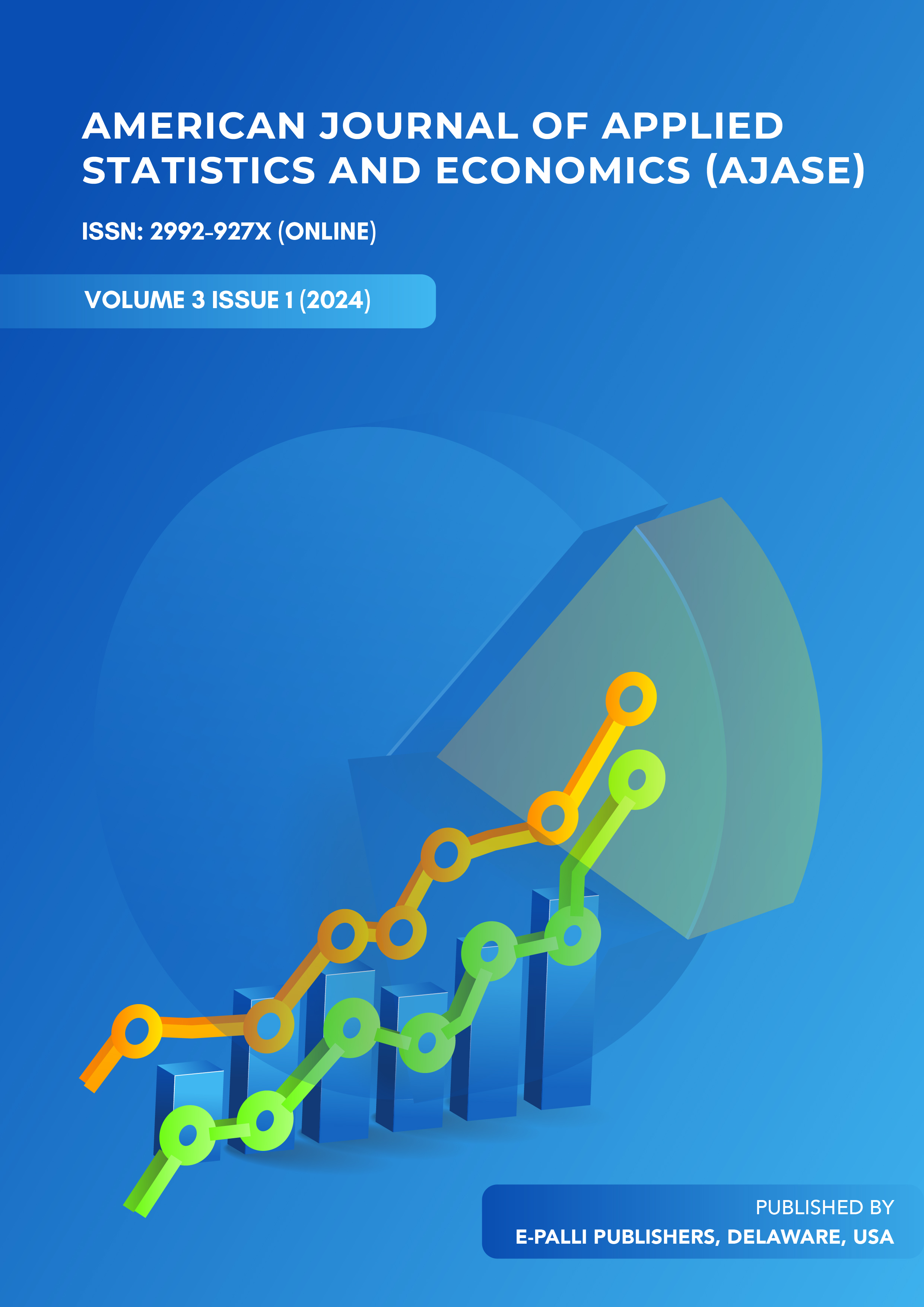Estimating Rural Premium and Financial Crisis Effect on the Nexuses between Food, Energy, and Water Consumption on Urban-Rural Income Gap in South–Eastern Asian Countries Using Pooled Regression Analysis
DOI:
https://doi.org/10.54536/ajase.v3i1.2600Keywords:
Energy, Food, Income Inequality, Poverty Gap, Poverty Rates, WaterAbstract
Poverty and inequality reduction and access to affordable clean energy and clean water are among the global sustainable development goals. Yet, researchers have overlooked how food, energy, and water (FEW) resources can be instrumental in reducing the urban-rural income gap. In this article, ordinary least squares regression analysis was used to estimate rural premium and financial crisis effect on the nexuses between food, energy, and water consumption on urban-rural income gap using a sample of data pooled from three Asian countries: China, India, and Indonesia over 2000 to 2019. No significant urban or crisis effect on the poverty rate was established. However, a significant crisis effect on the poverty gap was established, but not on the urban premium. A significant positive interaction between food insecurity and water was established. Water supply improves agricultural production, improves food security, and reduces poverty by raising income. However, modern clean energy is associated with rising income inequality. Modern energy technologies benefit a few wealthier individuals investing in the energy and agriculture sectors. Therefore, improved water access, particularly to support food production and affordability, and efficient utilization of clean fuels and technologies among all individuals, regardless of socio-economic class, are crucial to escaping poverty and achieving prosperity.
Downloads
References
Acheampong, A. O., Dzator, J., & Shahbaz, M. (2021). Empowering the powerless: does access to energy improve income inequality?. Energy Economics, 99, 105288. https://doi.org/10.1016/j.eneco.2021.105288
Ahmed, N., & Thompson, S. (2019). The blue dimensions of aquaculture: A global synthesis. Science of the Total Environment, 652, 851-861. https://doi.org/10.1016/j.scitotenv.2018.10.163
Akhtar, S., Ahmed, R., Begum, K., Das, A., & Banu, S. (2023). CRISPR/Cas in Improvement of Food Crops for Feeding the World into the Future. In Advanced Crop Improvement, Volume 2: Case Studies of Economically Important Crops (pp. 529-566). Cham: Springer International Publishing. https://doi.org/10.1007/978-3-031-26669-0_19
Baiyeri, P. K., Foleng, H. N., Machebe, N. S., & Nwobodo, C. E. (2019). Crop-livestock interaction for sustainable agriculture. Innovations in Sustainable Agriculture, 557-582. https://doi.org/10.1007/978-3-030-23169-9_18
Bartmann, R. (2017). Causes and effects of 2008 financial crisis. Furtwangen, Germany: HFU Business School, Internationale Betriebswirtschaft.
Biggs, E. M., Bruce, E., Boruff, B., Duncan, J. M., Horsley, J., Pauli, N., ... & Imanari, Y. (2015). Sustainable development and the water–energy–food nexus: A perspective on livelihoods. Environmental Science & Policy, 54, 389-397. https://doi.org/10.1016/j.envsci.2015.08.002
Descheemaeker, K., Bunting, S. W., Bindraban, P., Muthuri, C., Molden, D., Beveridge, M., ... & Jarvis, D. I. (2013). Increasing water productivity in agriculture. Managing water and agroecosystems for food security. Wallingford (UK): CABI Publishing, 104-123. Dimension_WDI_Time.
Dinesh, D. (2016). Agricultural practices and technologies to enhance food security, resilience and productivity in a sustainable manner: Messages to the SBSTA 44 agriculture workshops. http://hdl.handle.net/10568/71051
Dosi, G., Pereira, M. C., Roventini, A., & Virgillito, M. E. (2018). The effects of labour market reforms upon unemployment and income inequalities: an agent-based model. Socio-Economic Review, 16(4), 687-720. https://doi.org/10.1093/ser/mwx054
Duguma, B., & Janssens, G. P. (2021). Assessment of livestock feed resources and coping strategies with dry season feed scarcity in mixed crop–livestock farming systems around the gilgel gibe catchment, Southwest Ethiopia. Sustainability, 13(19), 10713. https://doi.org/10.3390/su131910713
FAO (Food and Agriculture Organization), (2021). Aquaculture production. [online; cited October 2023.] Available from URL: https://www.fao.org/3/cc0461en/online/sofia/2022/aquaculture-production.html
FAO (Food and Agriculture Organization), n.d., Livestock in crop land. [online; cited October 2023.] Available from URL: https://www.fao.org/3/x5304e/x5304e04.htm
Fitton, N., Alexander, P., Arnell, N., Bajzelj, B., Calvin, K., Doelman, J., ... & Smith, P. (2019). The vulnerabilities of agricultural land and food production to future water scarcity. Global Environmental Change, 58, 101944. https://doi.org/10.1016/j.gloenvcha.2019.101944
Gusha, B. (2019). Livestock Water Productivity: Towards Improving Rural Livelihoods from Livestock in Semi-Arid Rangelands (Doctoral dissertation, Rhodes University). https://commons.ru.ac.za/vital/access/services/Download/vital:34084/SOURCE1
Hashmi, H. A., Belgacem, A. O., Behnassi, M., Javed, K., & Baig, M. B. (2021). Impacts of Climate Change on Livestock and Related Food Security Implications—Overview of the Situation in Pakistan and Policy Recommendations. Emerging Challenges to Food Production and Security in Asia, Middle East, and Africa: Climate Risks and Resource Scarcity, 197-239. https://doi.org/10.1007/978-3-030-72987-5_8
Huang, H., Roland-Holst, D., Wang, C., & Cai, W. (2020). China’s income gap and inequality under clean energy transformation: A CGE model assessment. Journal of Cleaner Production, 251, 119626. https://doi.org/10.1016/j.jclepro.2019.119626
Krieger, T., & Meierrieks, D. (2019). Income inequality, redistribution and domestic terrorism. World Development, 116, 125-136. https://doi.org/10.1016/j.worlddev.2018.12.008
Lee, J. W., & Lee, H. (2018). Human capital and income inequality. Journal of the Asia Pacific Economy, 23(4), 554-583. https://doi.org/10.1080/13547860.2018.1515002
Ma, C., & Liao, H. (2018). Income elasticity of cooking fuel substitution in rural China: Evidence from population census data. Journal of cleaner production, 199, 1083-1091. https://doi.org/10.1016/j.jclepro.2018.06.215
Ma, S., Xu, X., Li, C., Zhang, L., & Sun, M. (2021). Energy consumption inequality decrease with energy consumption increase: Evidence from rural China at micro scale. Energy Policy, 159, 112638. https://doi.org/10.1016/j.enpol.2021.112638
Mayberry, D., Hau, D. K., Dida, P. R., Bria, D., Praing, J., Mata, A. D., ... & Nulik, J. (2021). Herbaceous legumes provide several options for increasing beef cattle productivity in eastern Indonesia. Animal Production Science, 61(7), 698-707. https://doi.org/10.1071/AN20545
Mbow, C., Rosenzweig, C. E., Barioni, L. G., Benton, T. G., Herrero, M., Krishnapillai, M., & Diouf, A. A. (2020). Food Security (No. GSFC-EDAA-TN78913).
Mills, D., Tilley-WorldFish, A., Pereira, M., & Fleming, A. (2019). project Exploring options to improve livelihoods and resource management in Timor-Leste’s coastal communities. https://www.aciar.gov.au/sites/default/files/project-page-docs/final_report_fis.2010.097.pdf
Monjardino, M., Philp, J. N. M., Kuehne, G., Phimphachanhvongsod, V., Sihathep, V., & Denton, M. D. (2020). Quantifying the value of adopting a post-rice legume crop to intensify mixed smallholder farms in Southeast Asia. Agricultural Systems, 177, 102690. https://doi.org/10.1016/j.agsy.2019.102690
Murshed, M. (2023). The relevance of reducing income inequality for eliminating urban-rural divide in clean cooking fuel accessibility: Evidence from Latin America and the Caribbean. Energy, 278, 127718. https://doi.org/10.1016/j.energy.2023.127718
Ndlovu, E., Prinsloo, B., & Le Roux, T. (2020). Impact of climate change and variability on traditional farming systems: Farmers’ perceptions from south-west, semi-arid Zimbabwe. Jàmbá: Journal of Disaster Risk Studies, 12(1), 1-19. http://dx.doi.org/10.4102/jamba.v12i1.742
Nilsson, M., Griggs, D., & Visbeck, M. (2016). Policy: map the interactions between Sustainable Development Goals. Nature, 534(7607), 320-322. https://doi.org/10.1038/534320a
OECD (Organisation for Economic Co-operation and Development), n.d., Water and agriculture. [online; cited October 2023.] Available from URL: https://www.oecd.org/agriculture/topics/water-and-agriculture/
Oishi, S., Kushlev, K., & Schimmack, U. (2018). Progressive taxation, income inequality, and happiness. American psychologist, 73(2), 157. https://psycnet.apa.org/doi/10.1037/amp0000166
Otte, J., Pica-Ciamarra, U., & Morzaria, S. (2019). A comparative overview of the livestock-environment interactions in Asia and Sub-Saharan Africa. Frontiers in Veterinary Science, 6, 37. https://doi.org/10.3389/fvets.2019.00037
Our World in Data, n.d. -a, “Global hunger index”. Our World in Data. [online; cited October 2023.] Available from URL: https://ourworldindata.org/grapher/global-hunger-index
Our World in Data., n.d. -b, “Installed solar energy capacity [Chart]. [online; cited October 2023.] Available from URL: https://ourworldindata.org/grapher/installed-solar-pv-capacity.
Pacific, A., East, M., America, S., & Content, S. (2024). Water, Energy, Food, and Terrorism: Towards a Nexus Approach. Energy & Environment. https://saisreview.sais.jhu.edu/water-energy-food-and-terrorism-towards-a-nexus-approach/
Roche, X., Rozstalnyy, A., TagoPacheco, D., Pittiglio, C., Kamata, A., Beltran Alcrudo, D., ... & Sumption, K. (2021). Introduction and spread of lumpy skin disease in South, East and Southeast Asia: Qualitative risk assessment and management. Food & Agriculture Org..
Sarkodie, S. A., & Adams, S. (2020). Electricity access, human development index, governance and income inequality in Sub-Saharan Africa. Energy Reports, 6, 455-466. https://doi.org/10.1016/j.egyr.2020.02.009
Tran, N., Rodriguez, U. P., Chan, C. Y., Phillips, M. J., Mohan, C. V., Henriksson, P. J. G., ... & Hall, S. (2017). Indonesian aquaculture futures: An analysis of fish supply and demand in Indonesia to 2030 and role of aquaculture using the AsiaFish model. Marine Policy, 79, 25-32. https://doi.org/10.1016/j.marpol.2017.02.002
UN, D., 2019, World population prospects 2019: Highlights. United Nations Department for Economic and Social Affairs. [online; cited October 2023.] Available from URL: https://population.un.org/wpp/Publications/Files/WPP2019_Highlights.pdf
United Nations Statistics Division, (2021). The Sustainable Development Goals Report 2021 - Extended Report: Goal 7. Indicator 7.1.2: Proportion of population with primary reliance on clean fuels and technology, p. 4. [online; cited October 2023.] Available from URL: https://unstats.un.org/sdgs/report/2021/extended-report/Goal%20%287%29_final.pdf
Uzar, U. (2020). Is income inequality a driver for renewable energy consumption?. Journal of cleaner production, 255, 120287. https://doi.org/10.1016/j.jclepro.2020.120287
World Bank, n.d.-a, Poverty and equity data portal. [online; cited October 2023.] Available from URL: https://pip.worldbank.org/poverty-calculator?src=BGD.
World Bank, n.d.-b., World development indicators. [online; cited October 2023.] Available from URL: https://databank.worldbank.org/source/world-development-indicators#selected
World Bank, n.d.-c., Prevalence of moderate or severe food insecurity in the population (%). [online; cited October 2023.] Available from URL: https://data.worldbank.org/indicator/SN.ITK.MSFI.ZS
Worldometer, 2023, Population of Asia (2023). Worldometer. [online; cited October 2023.] Available from URL: https://www.worldometers.info/world-population/asia-population/
Xu, Q., & Zhong, M. (2023). The impact of income inequity on energy consumption: The moderating role of digitalization. Journal of Environmental Management, 325, 116464. https://doi.org/10.1016/j.jenvman.2022.116464
Downloads
Published
How to Cite
Issue
Section
License
Copyright (c) 2024 Khambai Khamjalas

This work is licensed under a Creative Commons Attribution 4.0 International License.





